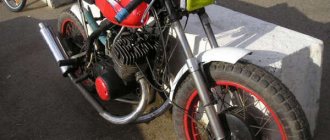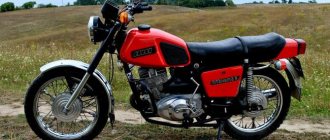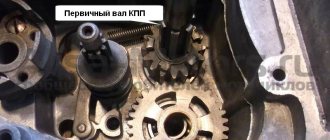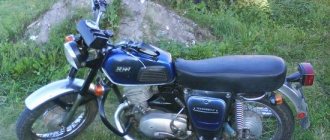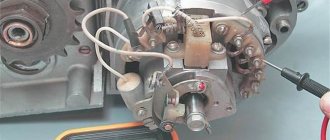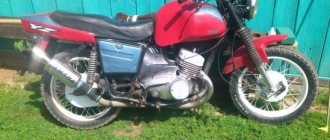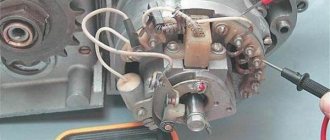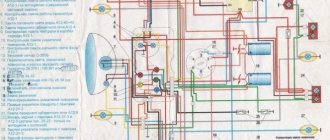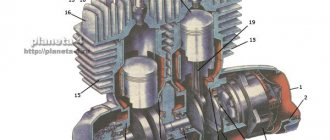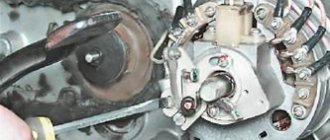Project “Boosting of the IZh “Planet-5” engine”
Topic: “Boosting the IZh “Planet-5” engine”
Relevance of the topic.
There is a large amount of technology on the modern market. This technique is expensive and has a complex engine design. Soviet IZH engines lag behind their foreign counterparts in their characteristics, but they have a simple design and are easy to modernize. Several decades ago, domestic motorcycles were in great demand, both in Russia and in neighboring countries. The main buyers of such equipment were rural residents. The reason for this interest is clear - simplicity of design and low price. In villages remote from the city there were no specialized centers for repairing motorcycles, so local residents had to solve engine repair problems on their own. They managed this without any problems. Over time, the appearance of our country has changed, and the needs of modern man have also changed. Nowadays it is very rare to see a Soviet motorcycle on the streets of a village, much less a city. This is due to the fact that modern Russian motorcycles are much inferior in their technical solutions to foreign manufacturers. To improve the performance of my personal motorcycle IZH “Planet5”, I decided to upgrade its engine.
Hypothesis:
boosting the Soviet IZH Planet engine will help change its technical parameters, which will ensure stable and uniform operation of the engine, both at idle and at high speeds, increase power, and balance the fuel supply to the cylinder.
Target:
boosting the IZH "Planet" engine to further improve the quality of its operation.
Tasks:
1. Study the literature on this issue.
2. Select the main components for boosting the engine.
3. Find the necessary elements to boost the engine and evaluate the economic benefits.
4. Upgrade the engine.
In the process of work I used the following research methods
:
1. theoretical (modelling, analogies, comparative analysis, generalization, integration)
2. empirical (conducting an experiment).
3. mathematical (data visualization method)
An object:
motorcycle IZH "Planet-5".
Item:
engine IZH "Planet-5".
Conclusions:
1. The literature on this issue has been studied.
2. The main components for boosting the engine were reasonably selected.
3. Selected engine components of the IZH Planet-5 motorcycle have been modernized.
Several units underwent modernization, which led to the following results:
1) the engine runs stably at idle and high speeds;
2) engine life has increased;
3) engine speed increased;
4) vibration decreased;
5) 92 grade gasoline can be used as fuel.
As a result of this work, the IZH Planet 5 engine was boosted.
Serial production of domestic motorcycles is closely related to the activities of Pyotr Vladimirovich Mozharov. This outstanding mechanic and talented designer in 1928 submitted a proposal to the government to produce serial motorcycles at factories in the city of Izhevsk. It was under his leadership that the first motorcycles under the IZH brand were created, tested and put into production. By the end of 1979, Izhevsk became the most important motorcycle manufacturing city in the former USSR. The conveyors of his factories could supply 350 thousand units of equipment per year. It was during these years that the IZH “Planet” motorcycle, famous throughout the country, appeared. This series gave birth to a lot of successful machines, unpretentious in operation and reliable in any conditions of use. A striking example was the beloved IZH “Planet 5” motorcycle.
IZh "Planet-5"
— a middle-class road motorcycle designed for riding on roads with different surfaces. Produced by the Izhevsk Machine-Building Plant from 1987 to 2008. The unpretentious and relatively inexpensive motorcycle model enjoyed deserved popularity. During the production process, the motorcycle was upgraded many times in terms of chassis and engine. It also has several configuration options.
The engine installed on these models has relatively high thrust at low speeds. It is possible to attach a side cargo or passenger trailer, or a universal cargo module to the motorcycle. It can also optionally be equipped with a luggage rack and knee guards.[1]
To reduce the clutch release force, the motorcycle uses a multi-plate (6 pairs) clutch with reinforced drive disc splines and a cam clutch release mechanism. Vibration dampers for the cylinder fins, together with a larger volume air cleaner, are designed to reduce the noise level produced by the motorcycle. [1]
The IZH Planet-5-01 motorcycle is a further modernization of the IZH Planet-5 motorcycle.[2]
The motorcycle began production in 1995, production was completed in 2007. Some of the technical solutions for the motorcycle were licensed and were originally intended for the promising IZH-Orion model.
The electrical system uses a permanent magnet generator with a contactless ignition system that operates independently of the battery, with automatically adjustable ignition timing.
The engine is equipped with a separate lubrication system pump, which eliminated the need to prepare and use a mixture of gasoline and oil in the motorcycle’s power system.
The gearbox is four-speed with an eccentric clutch release mechanism and a reinforced motor chain.
The front wheel brake is hydraulically driven disc or mechanically driven two-cam. The wheel suspensions use shock absorbers with improved characteristics and rebound springs, and the rear wheel suspension arm is mounted on rolling or sliding bearings. The kinematics of the rear wheel brake drive have been changed.
Technical parameters of the motorcycle.
| Options | Values | Notes |
| Weight | 158–165 kg | Average weight class according to the USSR classification. The weight of classic motorcycles produced today ranges from 70 to 250 kg |
| Maximum Load Weight | 170 kg, including 20 kg luggage | |
| Ground clearance (at maximum load) | 135 mm | |
| Wheels | spoked | |
| Distance between wheel axles | 145 cm | |
| Dimensions (roll bars, trunk, mirror and half-fairing are not taken into account). | ||
| Length | 220 cm | |
| Width | 81 cm | |
| Height | 120 cm | |
| Electric battery | 6MTS-9, 12 V, 9 Ah | |
| Electric generator | 7.107-3701010, single-phase, 90 W, 14 V | |
| Fuel consumption and motorcycle speed | ||
| Fuel tank capacity | 19 l | This gas tank capacity allows you to travel about 300 km without refueling along the way. Refill tanks are described in detail in the instruction manual. |
| Gasoline consumption (per 100 km) | 5–6 l | Modern motorcycles with similar characteristics consume 3 liters of fuel per 100 km. |
| Maximum driving speed | 120 km/h | Depends on the condition of the engine and other factors. The maximum speed of today's analogues is 100–140 km/h, and do not forget that they have a fifth gear. |
| Time to reach 100 km/h | 12–15 sec | |
| Brakes. | ||
| Front and rear wheel brakes | mechanically driven drum | Currently, drum brakes are considered obsolete, and modern motorcycles are equipped with disc brakes - single or double. |
| Braking distances | 6.5 m – at 30 km/h 42.6 m – at 80 km/h | |
Engine Specifications
| Engine | |
| Modification | Izh-P5 Sat. 1-0 |
| Type | in-line |
| Tact | 2 |
| Cylinders/Mufflers | 42005 |
| Working volume, cubic meters cm | 346 |
| Maximum power, kW (hp) | 16,2 (22) |
| Lubrication system | joint |
| Cooling system | air |
| Supply system | |
| Carburetor type | K65-I |
| Gasoline brand | A 76 |
| Fuel tank volume, l | 18 |
| Fuel consumption, l/100 km | 6 |
| Electrical equipment | |
| Ignition system | battery contact |
| Starting system | kickstarter |
| Electricity source | rechargeable battery, 12 V |
| Transmission | |
| Clutch | multi-disc in oil bath |
| Transmission | 4-speed |
| main gear | chain |
Engine problems and disadvantages:
1) Engine vibration;
2) High fuel consumption when raising the carburetor needle;
3) Weak acceleration of speed;
4) The piston is stuck to the cylinder walls;
5) Defective contact ignition (the spark is ahead of the piston).
Work plan.
1) Replacement of standard bearings with Japanese ones (not lower than quality 6) from AOUO. Replacing the bearings is necessary, since the speed after boosting the engine will increase, and standard domestic bearings of low class and quality will not withstand the increased speed and load. Replacing bearings will increase engine life.
2) Replacing the standard piston. When the engine is running, the standard piston is subject to sticking against the cylinder walls, which gives negative positions. This action leads to the destruction of the cylinder mirror. The standard piston can be replaced with a Japanese one.
3) Increasing the degree of compression of the combustible mixture. Increasing the compression ratio is one of the main methods for increasing engine power. This way you can get more output from the same engine size. In a word, the power will increase, but the consumption will remain the same. In this case, you will have to refuel with high-octane fuel.
4) Improve the balancing of the crankshaft, as well as its structure. Balancing the crankshaft will allow it to spin up to high speeds.
5) Increase the volume of the cylinder by boring the channels. After this, the filling of the combustible mixture will occur quickly and evenly. The engine power will increase.
7) Install the Mikuni carburetor. Installing this carburetor will increase the fuel supply, which will allow a balanced supply of fuel to the combustion chamber.
 Electronics change.
Electronics change.
Result.
When finalizing and changing the technical parameters of this engine, we have:
1) The engine runs stably at idle and high speeds;
2) Engine life has increased;
3) Engine speed has increased;
4) Vibrations have decreased;
5) You can use 92 grade gasoline as fuel.
In addition to its main purpose - to ride, the IZH "Planet - 5" motorcycle is an excellent assistant and a wonderful help in household farming.
The unpretentious vehicle has excellent maneuverability, and when equipped with a side or other universal trailer, it is capable of transporting up to 250 kilograms of various cargo at a time. It is not uncommon that, after modernization and alteration, the IZH “Planet -5” motorcycle was turned into a snowmobile, and sometimes even a mini-tractor. The modern market offers a large selection of different models of motorcycles for every taste and budget, however, I would like to hope that the new Izhevsk models will have as many admirers and lovers as the old, but still tenacious IZH “Planet-5”. Sources.
“Planet-Sport” is one of the best Soviet motorcycles, with which our industry reached its zenith. A bright and original design, decent “figures” and imported components allowed it to compete on equal terms with “foreign cars” even in foreign markets - an unthinkable success by today’s standards.
This text was written for the September issue of MOTO magazine, which was not published, as well as the October and November ones. Having survived the “damned 90s”, the rise from the knees of the 00s and the stability of the early 10s, the magazine, judging by the delay, could not stand the current state of affairs. Today, a well-restored PS is one of the few domestic motorcycles that are truly valuable to fans, and the price tags are rising every year. Demand also drives prices for spare parts, which are increasingly being labeled with a dozen labels - “rarity”, “shortage”, “early” and “Japanese”. For the red corner in the garage - yes, but no more.
For a Euryday motorcycle, the Japanese necroclassic, the face of which is the Yamaha SR400, is much better suited. Appearing in 1978, it can be considered the same age as Planet-Sport, which debuted in 1973, and much more successful - it is still sold in some markets. Why not the basis for restomod?
The union of the two grandmothers in this loving ecstasy did not seem a problem in theory, but in reality it took a long time. The main problem was the PS tank, which refused to sit on the thick pipe of the Yamaha frame, which acts as an oil tank. A friend came to the rescue, donating the lower part of his old SR tank and welding the top of the PS to it.
The fenders and lighting equipment fit without any problems, but the service had to tinker with the saddle and fork “flags”, welding the brackets and turning out the adapters. Stickers were applied to the early “PS”, but I preferred the later heavy metal nameplates, such decorations look more convincing.
The most expensive acquisition was an early speedometer with a “reverse” orange arrow; they managed to “make friends” with the Yamaha speedometer drive. But the remote controls and levers remained original, Japanese; all this old-fashioned fittings fit very organically into the look of the restomod.
The only thing that gives it away as a replica is the exhaust located on the “wrong” side and the large 4-stroke engine. It hurts not only the eyes, but also the nose - there are no sweet notes of refined sugar and condensed milk in the exhaust blend, so even the blind can call this motorcycle fake.
upd 14:12 And then a video with the participation of the subject arrived in time for the post.
Engine. Plans.
So, the engine was disassembled and washed. In general, the condition is a solid four. What we have:
1. The cylinder is original. First renovation. Measurements and a visual inspection showed that after boring the cylinder-piston group had not even been run-in. But the piston is in the trash, its quality is disgusting.
2. Crankshaft. I was expecting to see a remake. But no, we have a Soviet crankshaft without backlash or axial runout (very surprised, to be honest).
3. The gearbox is in excellent condition. The fit of the engagement pairs is quite good (the paint test showed a fit of 5 out of 5)
4. Reinforced (wide) motor transmission. Remade (the previous owner didn’t even remove the holographic sticker from the back of the basket). Made quite well, let's see how it performs.
5. The crankcase is in good condition, the mating surfaces are intact, without burrs or dents.
As for the problems, the classic illness of Izhi (well, “collective farm” repairs in general) has come out - many of the seats for the bearings are loose. The bearings are removed and installed by hand with little effort. The previous owner was a little far from the principle of operation of a motorcycle gearbox. How did I understand this? All bearings are new. And everything is closed. God, the gearbox has sealed bearings... I was very, very surprised, to say the least...
I disassembled and repaired the engine about a week ago. All this week I have been fine-tuning the engine and waiting for good things.
What did you do? The Internet is full of useless information on fine-tuning the IZh engine. 90% of it is complete nonsense. All the changes I make were tested by me personally on the motorcycles of my comrades many years ago. But now all this is done with a very competent approach.
What we want from the engine is to increase throttle response, power with an acceptable resource and consumption. It is necessary to increase the filling of the cylinder. This is done by increasing the intake and purge phases. To increase the speed, let's change the release phase.
So. CPG. The factory cylinder pleased me with the coincidence of the windows in the jacket and sleeve. Not bad already. The inlet window is 3mm down. Doesn't make sense anymore (based on theory and personal experience). Blowing - we clean all channels from casting defects, smooth out the corners and raise the blowing windows 2 mm up. The outlet window also did not avoid meeting with the drill). We raised it by 2 mm (I didn’t want more, there is no goal to achieve speeds over 10,000+). Polishing is a controversial issue. Mirror polishing does not produce any special effects. You can argue as much as you want. The main condition is the absence of ledges, roughness and sharp corners. Sanding with 800 grit sandpaper is sufficient. The piston was made to order (it cost me 1,500 rubles, because I did not want to suffer with a Chinese piston from the market, cast from spoons and forks). I ordered according to factory drawings, taking into account all tolerances, interference and ellipticity. The leading edge of the piston has a 3 mm cutout, and the side cutouts correspond to the windows in the liner (so as not to cut the piston later). But I still polished the piston bottom. Rings and piston pin from Soviet stocks (personal collection)
I haven’t cut the head yet, I’ll do it after assembling the engine, so as not to overdo it and push the piston face to face with the head))) since I don’t remember the position of the piston at TDC. We'll measure it later with plasticine.
I ordered all the bearings according to the first accuracy class. Made in Germany and France. I wanted to order an “elite” (NTN), but I realized that the original is extremely difficult to find (Hondo drivers will understand me). The set of bearings, including delivery, cost approximately 5 thousand rubles. Izhevody will call me a major and a pontorez, like Russian Izhak drives fine). Well, for them, diesel oil in the gearbox is normal (for me it’s a complete nightmare). But we are assembling a normal motor)
Today at lunch I picked up the crankcase from the boring man and adjusted the seats for the new bearings. Basically ready for assembly. All parts have been tested and measured.
I wish everyone who completed this text good luck)
The continuation is just around the corner!
Tags
- Engine modification
- tuning
